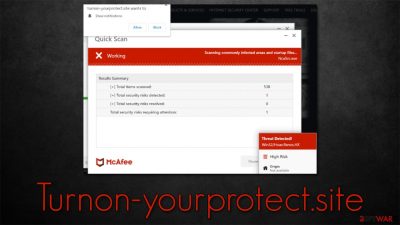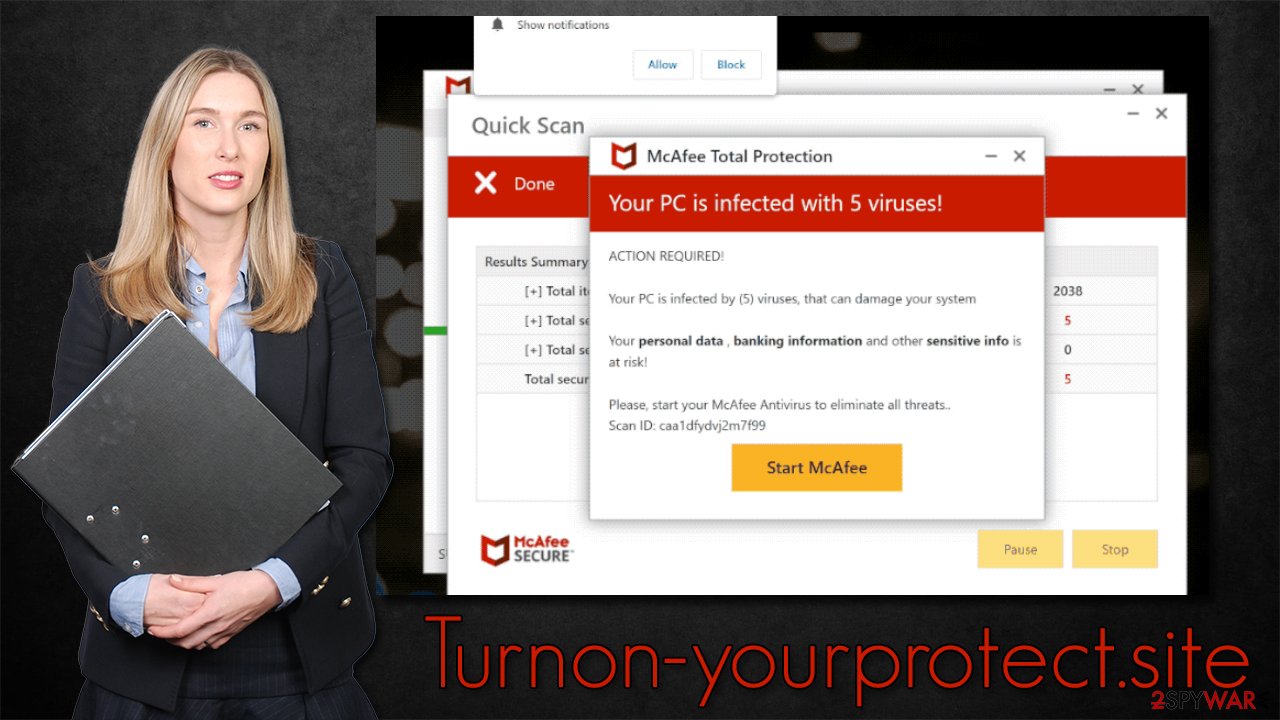Turnon-yourprotect.site ads (Free Instructions)
Turnon-yourprotect.site ads Removal Guide
What is Turnon-yourprotect.site ads?
Turnon-yourprotect.site ads are fake: here's what you should know

Turnon-yourprotect.site is a browser-based scam that can be encountered at any point during web browsing sessions on Google Chrome, Mozilla Firefox, MS Edge, or another browser. People do not visit the phishing website deliberately but are redirected to it from somewhere else, usually, high-risk websites such as torrents or illegal video streaming services.
Browser redirects to suspicious sites, especially when accompanied by intrusive advertisements (pop-ups, banners, deals, offers, coupons, etc.) might be a sign of adware infection, which is important to get rid of if one cares about their personal safety and computer security.
The purpose of the fake site is to make users believe that their computers are infected with various malware, and that removal software needs to be downloaded and installed in order to remediate this situation. In reality, Turnon-yourprotect.site is fake and has nothing to do with the original vendor it tries to portray.
The main foal of scammers is to make sure that users follow affiliated links,[1] which would consequently convert into profits for crooks. It is important not to support them; otherwise, it would only confirm that the malicious scheme works.
More about the scam message
Upon entry to Turnon-yourprotect.site, users are immediately presented with a warning in the blue background, which closely reminds Windows' Blue Screen of Death crash window. Immediately after that, an alleged system scan occurs- the items scanned are being shown, and pop-ups of the allegedly malicious files also come up. After that, the fake results are shown as follows:
Your PC is infected with 5 viruses!
ACTION REQUIRED!
Your Norton Subscription Has Expired!
Renew now to keep your pc protected.
If your PC is unprotected, it is at risk for viruses and other malware.
In reality, the message has nothing to do with Norton or any other legitimate security body. You should not trust these results and ensure your system is malware-free by trusting reputable security tools. Keep in mind that any message which claims virus infection is always fake, as there is no way to find out without performing a scan with a security application that must be installed on your system.

| Name | Turnon-yourprotect.site |
| Type | Scam, ads, redirect |
| Infiltration | Redirects from other websites, pop-up ads, potentially unwanted applications |
| Scam content | The scam is based on scaring users into believing that their systems are infected and that they need to remove those infections with promoted software |
| Dangers | Installation of PUPs or malware, sensitive information disclosure, financial losses |
| Removal | Interacting with the scam content is dangerous, as scammers may promote fake versions of antivirus software. Instead, use reputable tools for your system safety |
| Other tips | Third parties can employ cookies to continue tracking your online activities, so we recommended clearing browser caches and other leftover PUP files with FortectIntego |
Removal explained
The removal process depends on what is actually installed on your system and how you reacted to the Turnon-yourprotect.site scam message. You might have installed potentially dangerous software if you followed the fake links or interacted with other malicious websites you could have redirected to.
Even if you did not do any of that, it is important you take care of your system, as adware could be one of the main reasons why you encounter phishing[2] websites.
1. Check the system manually
Keep in mind that manual malware/adware removal might not always be successful, so if you don't feel like tampering with your system, you can simply skip the next step. Nonetheless, we still recommend cleaning browser caches regardless if you want to remove unwanted apps manually or automatically.
In order to remove unwanted browser add-ons, you should click the “Extensions” button next to the system menu and get rid of every item you find suspicious. Simply click the third dots and select “Uninstall.” Once you are sure that add-ons are deleted, you should check the list of the installed programs on the system level as follows:
Windows
- Enter Control Panel into Windows search box and hit Enter or click on the search result.
- Under Programs, select Uninstall a program.
![Uninstall from Windows 1 Uninstall from Windows 1]()
- From the list, find the entry of the suspicious program.
- Right-click on the application and select Uninstall.
- If User Account Control shows up, click Yes.
- Wait till uninstallation process is complete and click OK.
![Uninstall from Windows 2 Uninstall from Windows 2]()
Mac
While moving apps into Trash is usually how you delete most normal applications, adware tends to create additional files for persistence. Thus, you should look for .plist and other files that could be related to the virus. If you are not sure, skip this step entirely.
- From the menu bar, select Go > Applications.
- In the Applications folder, look for all related entries.
- Click on the app and drag it to Trash (or right-click and pick Move to Trash)
![Uninstall from Mac 1 Uninstall from Mac 1]()
To fully remove an unwanted app, you need to access Application Support, LaunchAgents, and LaunchDaemons folders and delete relevant files:
- Select Go > Go to Folder.
- Enter /Library/Application Support and click Go or press Enter.
- In the Application Support folder, look for any dubious entries and then delete them.
- Now enter /Library/LaunchAgents and /Library/LaunchDaemons folders the same way and terminate all the related .plist files.
After you are sure that your system is fully cleaned from potentially unwanted programs and malware, you should also take your time to clean your browsers from trackers such as cookies. To avoid privacy risks and increased possibility of session hijacking[3] attacks, you should delete these files on a regular basis – you can do that with FortectIntego maintenance utility which can also fix any malware damage on your system. Alternatively, proceed with the following steps:
Google Chrome
- Click on Menu and pick Settings.
- Under Privacy and security, select Clear browsing data.
- Select Browsing history, Cookies and other site data, as well as Cached images and files.
- Click Clear data.
![Clear cache and web data from Chrome Clear cache and web data from Chrome]()
Mozilla Firefox
- Click Menu and pick Options.
- Go to Privacy & Security section.
- Scroll down to locate Cookies and Site Data.
- Click on Clear Data…
- Select Cookies and Site Data, as well as Cached Web Content, and press Clear.
![Clear cookies and site data from Firefox Clear cookies and site data from Firefox]()
MS Edge (Chromium)
- Click on Menu and go to Settings.
- Select Privacy and services.
- Under Clear browsing data, pick Choose what to clear.
- Under Time range, pick All time.
- Select Clear now.
![Clear browser data from Chroum Edge Clear browser data from Chroum Edge]()
Safari
- Click Safari > Clear History…
- From the drop-down menu under Clear, pick all history.
- Confirm with Clear History.
![Clear cookies and website data from Safari Clear cookies and website data from Safari]()
2. Scan with security software
In order to ensure that no malicious software is running in the background, you should perform a full system scan with Malwarebytes, SpyHunter 5Combo Cleaner, or another powerful anti-malware software. This would not only remove all the malicious components from your system but will also serve as a shield from future malware attacks.
3. Get rid of push notifications [if applicable]
Upon entering the site, you might also be asked to enable push notifications. If you hit the “Allow” button within the prompt either intentionally or not, you would later be spammed with annoying pop-ups – they would show up at any time when the browser is in operation, regardless if it is being actively used.
To make matters worse, Turnon-yourprotect.site would show more misleading messages about virus infections and promote links to malicious websites, so make sure you don't interact with any of these. Instead, you need to access browser settings and block the website's URL from the “Allowed” list:
Google Chrome
- Open the Google Chrome browser and go to Menu > Settings.
- Scroll down and click on Advanced.
- Locate the Privacy and security section and pick Site Settings > Notifications.
- Look at the Allow section and look for a suspicious URL.
- Click the three vertical dots next to it and pick Block. This should remove unwanted notifications from Google Chrome.
![Stop notifications on Chrome PC 2 Stop notifications on Chrome PC 2]()
Mozilla Firefox
- Open Mozilla Firefox and go to Menu > Options.
- Click on Privacy & Security section.
- Under Permissions, you should be able to see Notifications. Click the Settings button next to it.
- In the Settings – Notification Permissions window, click on the URL's drop-down menu.
- Select Block and then click on Save Changes. This should remove unwanted notifications from Mozilla Firefox.
![Stop notifications on Mozilla Firefox 2 Stop notifications on Mozilla Firefox 2]()
Safari
- Click on Safari > Preferences…
- Go to the Websites tab and, under General, select Notifications.
- Select the web address in question, click the drop-down menu and select Deny.
![Stop notifications on Safari Stop notifications on Safari]()
MS Edge (Chromium)
- Open Microsoft Edge, and go to Settings.
- Select Site permissions.
- Go to Notifications on the right.
- Under Allow, you will find the unwanted entry.
- Click on More actions and select Block.
![Stop notifications on Edge Chromium Stop notifications on Edge Chromium]()
How to prevent from getting adware
Do not let government spy on you
The government has many issues in regards to tracking users' data and spying on citizens, so you should take this into consideration and learn more about shady information gathering practices. Avoid any unwanted government tracking or spying by going totally anonymous on the internet.
You can choose a different location when you go online and access any material you want without particular content restrictions. You can easily enjoy internet connection without any risks of being hacked by using Private Internet Access VPN.
Control the information that can be accessed by government any other unwanted party and surf online without being spied on. Even if you are not involved in illegal activities or trust your selection of services, platforms, be suspicious for your own security and take precautionary measures by using the VPN service.
Backup files for the later use, in case of the malware attack
Computer users can suffer from data losses due to cyber infections or their own faulty doings. Ransomware can encrypt and hold files hostage, while unforeseen power cuts might cause a loss of important documents. If you have proper up-to-date backups, you can easily recover after such an incident and get back to work. It is also equally important to update backups on a regular basis so that the newest information remains intact – you can set this process to be performed automatically.
When you have the previous version of every important document or project you can avoid frustration and breakdowns. It comes in handy when malware strikes out of nowhere. Use Data Recovery Pro for the data restoration process.
- ^ Affiliate Link. Techopedia. Technology dictionary.
- ^ Phishing attacks. Imperva. Application and data security.
- ^ Allie Johnson. Session hijacking: What is a session hijacking and how does it work?. Norton. Security research blog.











